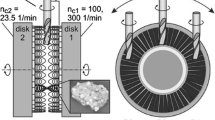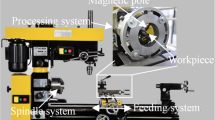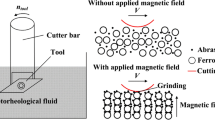Abstract
Magnetoelastic abrasive particles are new composite particles formed by abrasive-phase alumina particles, magnetic-medium-phase iron particles, and a polymer matrix in a specific proportion. Abrasive particles exhibit both viscoelasticity and magnetic conductivity. In this study, we propose a preparation method for magnetoelastic abrasive particles and build up a magnetoelastic abrasive dual-disk magnetic edge preparation equipment. Based on the characteristics of the abrasive particles and the dual-disk magnetic edge preparation, a mathematical model of material removal by a single magnetoelastic abrasive particle is established considering the effects of multiple factors, such as the volume fraction of the constituent particles, abrasive particle size, disk rotational speed, and disk spacing. According to the number of active alumina abrasive particles acting on the tool surface and the movement trajectory of the magnetoelastic abrasive particles, we establish a mathematical model of material removal by magnetoelastic abrasive particles. We combine this model with tool edge preparation experiments to study the influence of the magnetoelastic abrasive particle size, disk spacing, and disk rotational speed on the surface roughness of the cutting edge and the amount of material removed from the cutting edge. The results show that the largest (smallest) discrepancy between the theoretical and experimental values for the amount of removed material is 15.8% (3.3%). After the edge preparation, the surface gloss of the tool is improved, and the surface roughness is significantly reduced by 54.72%, which indicates that the introduction of magnetoelastic abrasive particles in the dual-disk tool edge preparation equipment can effectively improve the surface quality of the tool. These results are of great scientific and engineering significance for the application of magnetoelastic abrasive particles to tool edge preparation as well as for promoting the advancement of magnetic high-efficiency machining and magnetic finishing machining.
















Similar content being viewed by others
References
Denkena B, Biermann D (2014) Cutting edge geometries. CIRP annals 63(2):631–653. https://doi.org/10.1016/j.cirp.2014.05.009
Pérez-Salinas CF, Del Olmo A, López de Lacalle LN (2022) Estimation of drag finishing abrasive effect for cutting edge preparation in broaching tool. Materials 15(15):5135. https://doi.org/10.3390/ma15155135
Hartig J, Kirsch B, Aurich JC (2022) Analysis of the grinding wheel wear and machining result during cutting edge preparation with elastic bonded grinding wheels. J Manuf Process 75:181–202. https://doi.org/10.1016/j.jmapro.2021.12.049
Gadge M, Lohar G, Chinchanikar S (2022) A review on micro-blasting as surface treatment technique for improved cutting tool performance. Mater Today: Proc 64:725–730. https://doi.org/10.1016/j.matpr.2022.05.196
Fulemova J, Janda Z (2014) Influence of the cutting edge radius and the cutting edge preparation on tool life and cutting forces at inserts with wiper geometry. Procedia Eng 69:565–573. https://doi.org/10.1016/j.proeng.2014.03.027
Peter P, Boris P, Tomáš V, Jozef P, Marek V, Vladimír Š (2020) Cutting edge radius preparation. Mater Today: Proc 22:212–218. https://doi.org/10.1016/j.matpr.2019.08.090
Bergs T, Schneider SAM, Amara M, Ganser P (2020) Preparation of symmetrical and asymmetrical cutting edges on solid cutting tools using brushing tools with filament-integrated diamond grits. Procedia CIRP 93:873–878. https://doi.org/10.1016/j.procir.2020.04.028
Malkorra I, Souli H, Claudin C, Salvatore F, Arrazola P, Rech J, Seux H, Mathis A, Rolet J (2021) Identification of interaction mechanisms during drag finishing by means of an original macroscopic numerical model. Int J Mach Tools Manuf 168:103779. https://doi.org/10.1016/j.ijmachtools.2021.103779
Wang W, Biermann D, Aßmuth R, Arif AFM, Veldhuis SC (2020) Effects on tool performance of cutting edge prepared by pressurized air wet abrasive jet machining (PAWAJM). J Mater Process Technol 277:116456. https://doi.org/10.1016/j.jmatprotec.2019.116456
Qi H, Qin S, Cheng Z, Zou Y, Cai D, Wen D (2021) DEM and experimental study on the ultrasonic vibration-assisted abrasive finishing of WC-8Co cemented carbide cutting edge. Powder Technol 378:716–723. https://doi.org/10.1016/j.powtec.2020.10.043
Denkena B, Köhler J, Schindler A (2014) Behavior of the magnetic abrasive tool for cutting edge preparation of cemented carbide end mills. Prod Eng 8:627–633. https://doi.org/10.1007/s11740-014-0569-4
Yamaguchi H, Srivastava AK, Tan M, Hashimoto F (2014) Magnetic abrasive finishing of cutting tools for high-speed machining of titanium alloys. CIRP J Manuf Sci Technol 7(4):299–304. https://doi.org/10.1016/j.cirpj.2014.08.002
De Santana MI, Polli ML (2022) Effects of tool edge preparation on tool life in drilling of SAE4144M steel. Int J Precis Eng Manuf 23(10):1113–1122. https://doi.org/10.1007/s12541-022-00691-6
Yang Y, Xue Y, Li B, Fu Y, Jiang Y, Chen R, Sun X (2022) A magnetic abrasive finishing process with an auxiliary magnetic machining tool for the internal surface finishing of a thick-walled tube. Machines 10(7):529. https://doi.org/10.3390/machines10070529
Naveen K, Shanbhag VV, Balashanmugam N, Vinod P (2018) Ultra-precision finishing by magnetic abrasive finishing process. Mater Today: Proc 5(5):12426–12436. https://doi.org/10.1016/j.matpr.2018.02.222
Farwaha HS, Deepak D, Brar GS (2020) Microstructure and performance investi- gation of magnetic abrasive particles. J Crit Rev 7(19):289–295. https://doi.org/10.3838/jcr.07.19.34
Baron YM, Ko SL, Park JI (2005) Characterization of the magnetic abrasive finishing method and its application to deburring. Key Eng Mater 291:291–296. https://doi.org/10.4028/www.scientific.net/KEM.291-292.291
Preston FW (1927) The theory and design of plate glass polishing machines. J Society of glass Tech 11:214
DeGroote JE, Marino AE, Wilson JP, Bishop AL, Lambropoulos JC, Jacobs SD (2007) Removal rate model for magnetorheological finishing of glass. Appl Opt 46(32):7927–7941. https://doi.org/10.1364/AO.46.007927
Misra A, Pandey PM, Dixit US (2017) Modeling of material removal in ultrasonic assisted magnetic abrasive finishing process. Int J Mech Sci 131:853–867. https://doi.org/10.1016/j.ijmecsci.2017.07.023
Qin C, Hu Z, Tang A, Yang Z, Luo S (2020) An efficient material removal rate prediction model for cemented carbide inserts chemical mechanical polishing. Wear 452:203293. https://doi.org/10.1016/j.wear.2020.203293
Kum CW, Sato T, Guo J, Liu K, Butler D (2018) A novel media properties-based material removal rate model for magnetic field-assisted finishing. Int J Mech Sci 141:189–197. https://doi.org/10.1016/j.ijmecsci.2018.04.006
Gao Y, Zhao Y, Zhang G, Yin F, Zhang H (2020) Modeling of material removal in magnetic abrasive finishing process with spherical magnetic abrasive powder. Int J Mech Sci 177:105601. https://doi.org/10.1016/j.ijmecsci.2020.105601
Khattri K, Choudhary G, Bhuyan BK, Selokar A (2018) A review on para- metric analysis of magnetic abrasive machining process. In IOP conference series: materials science and engineering. 330(1):012105. https://doi.org/10.1088/1757-899X/330/1/012105
Zhao X,Qin H,Yang Y et al (2021) Study on magnetic preparation of dual disk based on silica gel magneto elastic abrasive particles. J Northwest Polytech Univ 39(6):1304–1311. (in Chinese)
Jain VK (2009) Magnetic field assisted abrasive based micro-/nano-finishing. J Mater Process Technol 209(20):6022–6038. https://doi.org/10.1016/j.jmatprotec.2009.08.015
Shinmura T, Takazawa K, Hatano E, Matsunaga M, Matsuo T (1990) Study on magnetic abrasive finishing. CIRP annals 39(1):325–328. https://doi.org/10.1016/S0007-8506(07)61064-6
Barber JR (2018) Contact mechanics[M]. Berlin: Springer International Publishing
Jain VK, Kumar R, Dixit PM, Sidpara A (2009) Investigations into abrasive flow finishing of complex workpieces using FEM. Wear 267(1–4):71–80. https://doi.org/10.1016/j.wear.2008.11.005
Kogut L, Etsion I (2002) Elastic-plastic contact analysis of a sphere and a rigid flat. J Appl Mech 69(5):657–662. https://doi.org/10.1115/1.1490373
Sooraj VS, Radhakrishnan V (2015) Investigations on the application of elastomagnetic abrasive balls for fine finishing. J Manuf Sci Eng 137(2):021018. https://doi.org/10.1115/1.4029375
Archard J (1953) Contact and rubbing of flat surfaces. J Appl Phys 24(8):981–988. https://doi.org/10.1063/1.1721448
Funding
This work was supported by the National Natural Science Foundation of China (Grant No. 52065012), and the Guizhou Province Science and Technology Plan Project, China (Grant No. Qiankehe Foundation – ZK [2022] General 153).
Author information
Authors and Affiliations
Contributions
H. W.: investigation, methodology, writing, and original draft; X. Z.: supervision, writing revision; Y. Y.: data curation, formal analysis; P. L.: data curation, formal analysis; Y. L.: data curation, formal analysis.
Corresponding author
Ethics declarations
Ethical approval
The authors state that this paper is an original work, it has not been published in any journals, and this research does not involve any ethical issues of humans or animals.
Consent to participate
All authors are aware and satisfied with the authorship order and correspondence of the paper.
Consent for publication
All the authors have consented to publication and have been approved by the institutions to which this work belongs.
Competing interests
The authors declare no competing interests.
Additional information
Publisher's Note
Springer Nature remains neutral with regard to jurisdictional claims in published maps and institutional affiliations.
Rights and permissions
Springer Nature or its licensor (e.g. a society or other partner) holds exclusive rights to this article under a publishing agreement with the author(s) or other rightsholder(s); author self-archiving of the accepted manuscript version of this article is solely governed by the terms of such publishing agreement and applicable law.
About this article
Cite this article
Wu, H., Zhao, X., Yuan, Y. et al. Material removal model of magnetoelastic abrasive particles in dual-disk magnetic cutting edge preparation. Int J Adv Manuf Technol (2024). https://doi.org/10.1007/s00170-024-13545-4
Received:
Accepted:
Published:
DOI: https://doi.org/10.1007/s00170-024-13545-4




